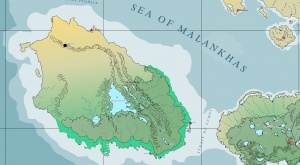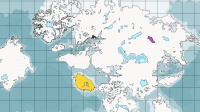Difference between revisions of "Ptohlia"
Trismegistus (talk | contribs) m (→List of Sites) |
Trismegistus (talk | contribs) m |
||
| Line 8: | Line 8: | ||
The island has no central authority and is populated by indigenous tribes of humans, [[ratfolk]], and other [[humanlike]]s. [[Zephasia]]n and [[Hœrnect]]ian legends report that anciently a great king united and ruled the entire island. [[Laugyathund's Isbajath]] took place on the eastern coast of the island in the late twenty fourth century, but is thought to have had no lasting effect on indigenous chaos cults. It not unusual for expeditions to visit the island and never return to civilization or to visit the island and discover nothing of note. In ancient times, the island was a source of gold, silver, and semi-precious gemstones. Foreign powers have simultaneously vowed either to protect or avoid interfering with the indigenous tribes while at the same time sending expeditions to explore and search for strategic resources. | The island has no central authority and is populated by indigenous tribes of humans, [[ratfolk]], and other [[humanlike]]s. [[Zephasia]]n and [[Hœrnect]]ian legends report that anciently a great king united and ruled the entire island. [[Laugyathund's Isbajath]] took place on the eastern coast of the island in the late twenty fourth century, but is thought to have had no lasting effect on indigenous chaos cults. It not unusual for expeditions to visit the island and never return to civilization or to visit the island and discover nothing of note. In ancient times, the island was a source of gold, silver, and semi-precious gemstones. Foreign powers have simultaneously vowed either to protect or avoid interfering with the indigenous tribes while at the same time sending expeditions to explore and search for strategic resources. | ||
| − | Known indigenous settlements include [[Onesir]] and [[Fahingu]]. Mixed indigenous and ratfolk coastal towns include [[Afitancho]] and [[Mauhu]]. These coastal towns, like [[Tatuku]], are havens for pirates and bootleggers as well as fishing fleets. | + | Known indigenous settlements include [[Onesir]] and [[Fahingu]]. Mixed indigenous and ratfolk coastal towns include [[Afitancho]] and [[Mauhu]]. These coastal towns, like [[Tatuku]], are havens for pirates and bootleggers as well as fishing fleets. [[Gumoa]] is an autonomous city ruled by merchant princes, principally from [[Medibgóëse Gonfaloy]]. |
Jalazin (/ʤalaˈziːn/), an autonomous city-state on the coast of the northern desert was established in the 1300's by [[Narshad|Narsadese]], [[Shagrela'al]]ite and [[Zephasia]]n sea traders. Incarnandist monastics established the [[Sanctuary of Rhionantis of Perpetual Abnegation]] in accordance with their order in the northern [[Omantikumun Mountains]]. The Gorcorumbese colonial city of [[Lanksha Miri]] was established around 2510 in the mountains. The ratfolk settlement of [[Tatuku]] rests on an island off the southeast coast of Ptohlia. Tatuku is a nexus of ratfolk and human traders and marine merchants and is either a tax haven or a den of pirates depending upon whom one asks. | Jalazin (/ʤalaˈziːn/), an autonomous city-state on the coast of the northern desert was established in the 1300's by [[Narshad|Narsadese]], [[Shagrela'al]]ite and [[Zephasia]]n sea traders. Incarnandist monastics established the [[Sanctuary of Rhionantis of Perpetual Abnegation]] in accordance with their order in the northern [[Omantikumun Mountains]]. The Gorcorumbese colonial city of [[Lanksha Miri]] was established around 2510 in the mountains. The ratfolk settlement of [[Tatuku]] rests on an island off the southeast coast of Ptohlia. Tatuku is a nexus of ratfolk and human traders and marine merchants and is either a tax haven or a den of pirates depending upon whom one asks. | ||
Revision as of 17:37, 18 April 2021

Ptohlia is a great island in the eastern Askonian Ocean, bounded to the north by the Sea of Malankhas and to the south by the Chaos Sea. The island is largely tropical and semi-tropical. The northernmost tip is semi-arid, called the Azrad Desert. A chain of rugged mountains stretches from the south to the north. Most of the southern coasts are salt marshes leading into the sea. South central Ptohlia is dominated by the Sea of Tiselaph, a fresh water body. The forested south is divided into three regions, the Kuvakwaip Forest, the Ulliontsi Forest, and the Chomolshandi Forest.
Despite the lack of a single authority, the indigenous tribes have fended off most attempts at colonization from external powers through the use of powerful chaos magic and powerful numinism. The relative independence of the island and its lack of most modern technology and customs remain as marvels to many.
The island has no central authority and is populated by indigenous tribes of humans, ratfolk, and other humanlikes. Zephasian and Hœrnectian legends report that anciently a great king united and ruled the entire island. Laugyathund's Isbajath took place on the eastern coast of the island in the late twenty fourth century, but is thought to have had no lasting effect on indigenous chaos cults. It not unusual for expeditions to visit the island and never return to civilization or to visit the island and discover nothing of note. In ancient times, the island was a source of gold, silver, and semi-precious gemstones. Foreign powers have simultaneously vowed either to protect or avoid interfering with the indigenous tribes while at the same time sending expeditions to explore and search for strategic resources.
Known indigenous settlements include Onesir and Fahingu. Mixed indigenous and ratfolk coastal towns include Afitancho and Mauhu. These coastal towns, like Tatuku, are havens for pirates and bootleggers as well as fishing fleets. Gumoa is an autonomous city ruled by merchant princes, principally from Medibgóëse Gonfaloy.
Jalazin (/ʤalaˈziːn/), an autonomous city-state on the coast of the northern desert was established in the 1300's by Narsadese, Shagrela'alite and Zephasian sea traders. Incarnandist monastics established the Sanctuary of Rhionantis of Perpetual Abnegation in accordance with their order in the northern Omantikumun Mountains. The Gorcorumbese colonial city of Lanksha Miri was established around 2510 in the mountains. The ratfolk settlement of Tatuku rests on an island off the southeast coast of Ptohlia. Tatuku is a nexus of ratfolk and human traders and marine merchants and is either a tax haven or a den of pirates depending upon whom one asks.
List of Sites
- Afitancho
- Azrad Desert
- Chomolshandi Forest
- Fahingu
- Gumoa
- Jalazin
- Kuvakwaip Forest
- Lake Pisgag
- Lanksha Miri
- Mauhu
- Omantikhumum Mountains
- Onesir
- Sanctuary of Rhionantis of Perpetual Abnegation
- Sea of Tiselaph
- Tatuku
- Uliontsi Forest
See Also
| This article is a stub. It requires further development by the creator. |
